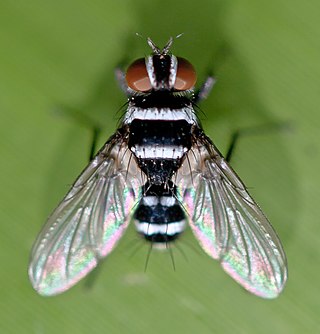
Eriothrix rufomaculatus is a species of fly in the family Tachinidae.

Gymnosoma nudifrons is a species of fly in the family Tachinidae.
Prosheliomyia formosensis is a species of fly in the family Tachinidae.
Hystriomyia is a genus of flies in the family Tachinidae.
Belida is a genus of flies in the family Tachinidae.
Cyrtophloeba is a genus of flies in the family Tachinidae.
Opsomeigenia is a genus of parasitic flies in the family Tachinidae.
Schineria is a genus of flies in the family Tachinidae.

Trigonospila is a small genus of parasitic flies in the family Tachinidae.

Tachina fera is a species of fly in the genus Tachina of the family Tachinidae. It was first described by Carl Linnaeus in 1761.
Prooppia is a genus of parasitic flies in the family Tachinidae.

Thelaira solivaga is a species of fly in the family Tachinidae.

Dexia rustica is a species of fly in the family Tachinidae.

Phasia obesa is a species of 'parasitic flies' belonging to the family Tachinidae subfamily Phasiinae.
Eriothrix argyreatus is a species of fly in the family Tachinidae.
Sturmiopsis inferens is a species of fly in the family Tachinidae. It is native to Asia and is a parasitoid of various moth species whose larvae feed inside the stems of sugarcane, rice and other large grasses, including the Gurdaspur borer and the sugarcane shoot borer.

Phania speculifrons is a species of fly in the family Tachinidae.

Hemipenthes maura is a species of bee fly belonging to the family Bombyliidae.
Feriola insularis is a species of fly in the family Tachinidae.
Prosheliomyia sibuyana is a species of fly in the family Tachinidae.












